Predictive analytics tools help marketers forecast campaign outcomes using data, machine learning, and statistical models. These tools analyze customer behavior, sales history, and market trends to refine strategies, improve ROI, and make data-driven decisions. Here's a quick overview of the top 7 tools:
- Pecan AI: Low-code platform for easy predictive modeling.
- Qlik Sense: Visual analytics with "what-if" scenario modeling.
- SAS Advanced Analytics: Enterprise-level statistical modeling and data governance.
- Alteryx: Drag-and-drop workflows for non-technical users.
- Marketing Evolution (MEVO): Real-time campaign optimization with machine learning.
- SAP Predictive Analytics: Integrated with SAP systems for enterprise scalability.
- Tableau: Data visualization and real-time forecasting.
Quick Comparison Table
| Tool | Ease of Use | Key Features | Ideal For | Pricing |
|---|---|---|---|---|
| Pecan AI | ⭐⭐⭐⭐⭐ | Low-code, CRM integration | Small teams, non-tech users | Custom quotes |
| Qlik Sense | ⭐⭐⭐⭐ | Scenario modeling, real-time data | Mid-size businesses | Subscription |
| SAS Advanced | ⭐⭐⭐ | Statistical modeling, governance | Large enterprises | Custom pricing |
| Alteryx | ⭐⭐⭐⭐ | Drag-and-drop workflows | Data analysts, mixed skill teams | Role-based |
| Marketing Evolution | ⭐⭐⭐⭐ | Real-time optimization, ROI tools | Marketing teams | Custom pricing |
| SAP Predictive | ⭐⭐⭐ | Enterprise-ready, scenario planning | Large enterprises | Custom pricing |
| Tableau | ⭐⭐⭐⭐⭐ | Data visualization, real-time updates | All team sizes | $15-$70/user/mo |
These tools vary in features, scalability, and pricing, making it crucial to match the tool to your team's needs. For beginners, Pecan AI or Qlik Sense are great starting points. Larger organizations may benefit from SAS Advanced Analytics or SAP Predictive Analytics for advanced capabilities. Ready to dive deeper? Keep reading for detailed insights into each tool.
How Predictive Analytics and Generative AI Help You Forecast and Plan Your Future Marketing Success
What are Predictive Analytics Tools?
Predictive analytics tools are software programs designed to use historical data, statistical methods, and machine learning to predict future campaign outcomes. They play a key role in marketing by turning raw data into insights that inform decisions.
These tools analyze various data sources, including past campaign results, customer behavior, and market trends, to identify patterns. By applying machine learning and statistical techniques, they help marketers fine-tune timing, messaging, and channel strategies for different audience groups.
Main Features of Predictive Analytics Tools:
- Data Mining: Identifies patterns in large datasets.
- Machine Learning: Learns and improves with new data over time.
- Statistical Modeling: Produces forecasts based on data.
- Data Visualization: Presents insights clearly using dashboards.
A standout feature of modern tools is their ability to integrate with other systems. They connect with CRMs, marketing platforms, and analytics tools to give teams a unified view of campaign performance. This shared access helps sales and marketing teams align their efforts based on the same data-driven insights.
However, the effectiveness of these tools depends on the quality of data and proper setup. Common challenges include ensuring clean data, building expertise, interpreting results correctly, and adhering to ethical data practices.
1. Pecan AI
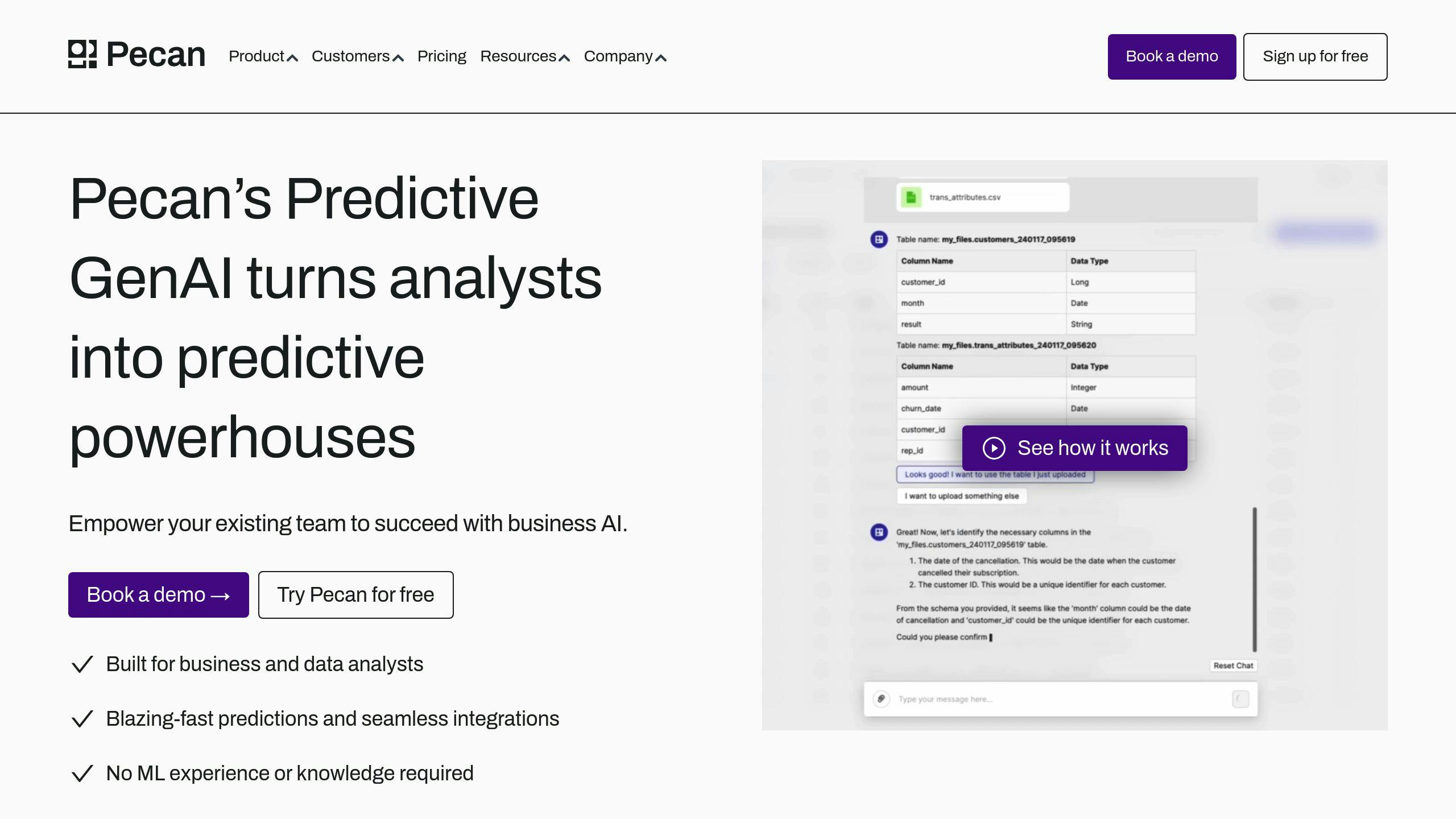
Pecan AI is a low-code platform designed for predictive analytics, helping marketers forecast campaign results without needing advanced data science skills. Its user-friendly interface and automated tools make predictive modeling quicker and more straightforward, enabling smarter, data-based decisions.
Key Features:
- AI-powered tools for building predictive models
- Automated SQL code generation for data queries
- Custom templates tailored to various campaign forecasting needs
- Compatibility with major marketing platforms and CRM systems
Platform Integration and Support
Pecan AI works seamlessly with popular marketing tools and CRMs, ensuring data security through encryption and adherence to key regulations. It provides comprehensive resources like documentation and tutorials, along with scalable infrastructure to accommodate businesses of any size.
Pricing is flexible and depends on specific business requirements. To get the best results, companies should have well-organized, clean data ready for analysis. The platform performs better when there's a rich history of campaign data available for modeling.
With its mix of ease of use and advanced functionality, Pecan AI is a reliable option for marketers who want accurate campaign forecasts.
2. Qlik Sense
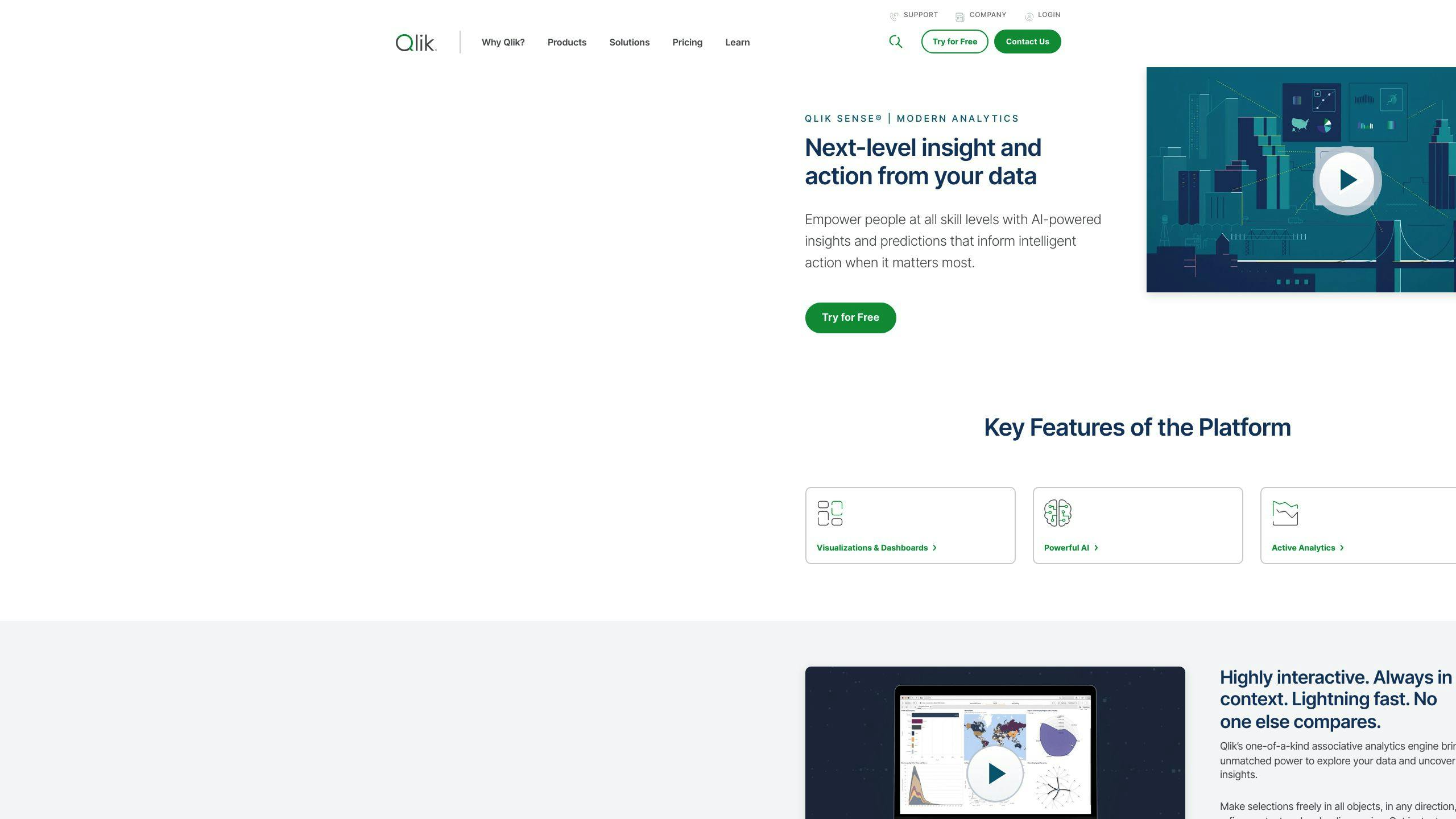
Qlik Sense is a predictive analytics platform that combines advanced data science tools with an easy-to-use interface. It helps marketers predict campaign outcomes using machine learning and scenario analysis.
Key Features:
- AI-driven analytics and machine learning
- Real-time data integration and visualizations
- Automated alerts for monitoring
- Tools for data preparation and management
- "What-if" scenario modeling
One of its standout features is its ability to clean and manage data effectively, ensuring accurate predictions. With APIs, Qlik Sense seamlessly integrates with marketing platforms, allowing users to analyze data from multiple sources in one place.
Marketers can use Qlik Sense to review past campaign performance, predict future results, and test different strategies to refine their approach. Its combination of powerful analytics and ease of use makes it a good fit for businesses of all sizes.
Qlik Sense is available as a cloud-based or on-premises solution and offers extensive support, including training and community forums. Its intuitive design allows marketing teams to create forecasts without needing coding skills, while still delivering advanced analytical tools.
For marketing teams looking for a tool that blends ease of use with strong analytics, Qlik Sense is a solid option. Next, we’ll dive into SAS Advanced Analytics, a platform tailored for more detailed statistical modeling.
3. SAS Advanced Analytics
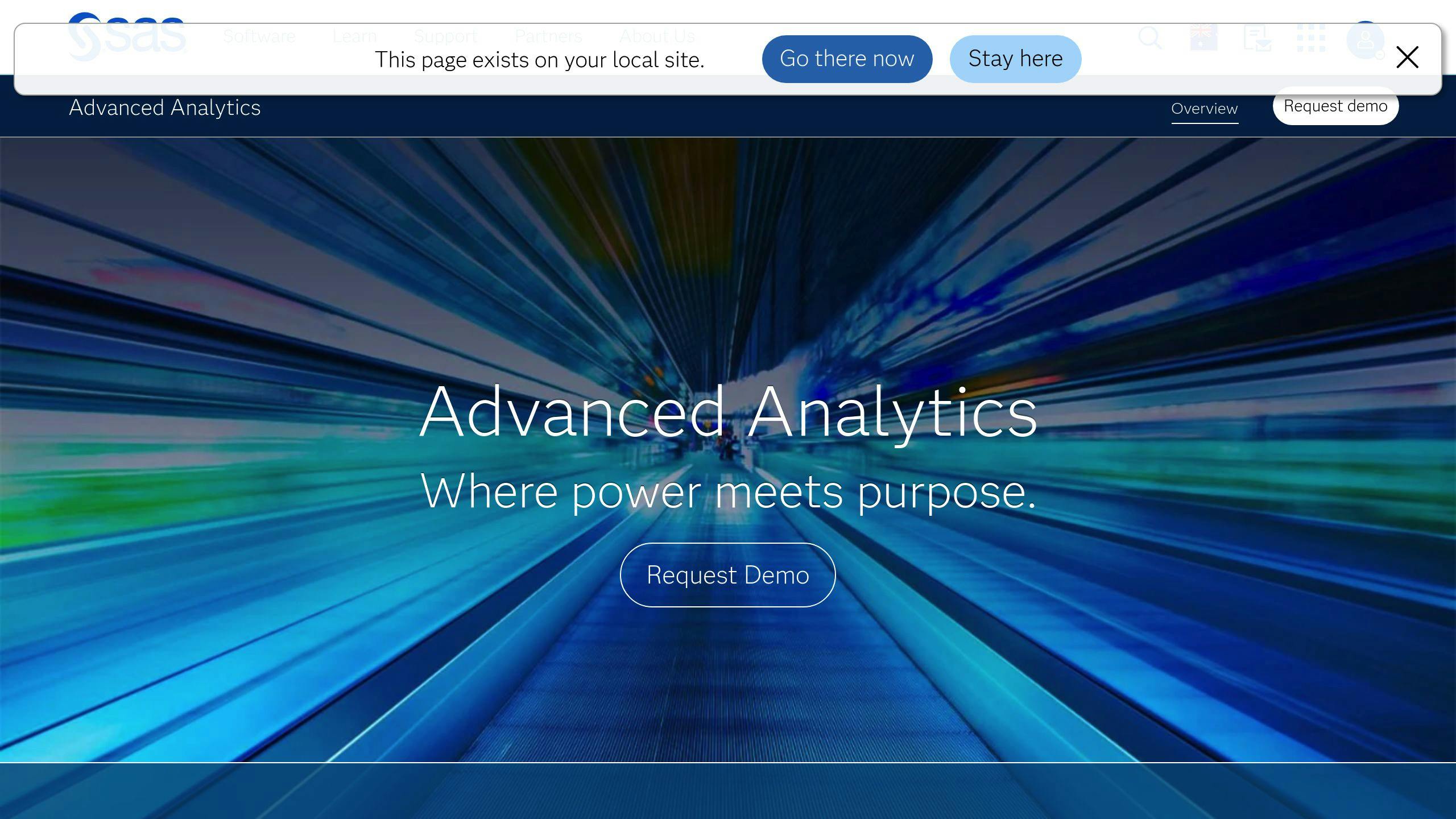
SAS Advanced Analytics is a powerful tool for predictive analytics, combining advanced data mining with statistical modeling to help marketing teams forecast campaigns with precision. It’s a solid choice for businesses in need of detailed, enterprise-level forecasting capabilities.
Key Features
- Advanced data mining and statistical tools
- Automated tools for data preparation and cleaning
- Strong data governance functionalities
- Real-time deployment of predictive models
- Tools for creating visual reports
What makes this platform stand out is its ability to manage complex predictive models while ensuring data accuracy and transparency. Its data governance features, such as model lineage tracking, are particularly useful for delivering reliable campaign forecasts.
Another strength of SAS Advanced Analytics is its scalability and deployment flexibility. Thanks to its distributed computing capabilities, it can handle large datasets efficiently - an essential feature for comprehensive forecasting efforts.
The platform also excels in integration. With its robust APIs and data connectors, it simplifies the process of consolidating data from multiple marketing channels. This enables teams to build unified predictive models using data from various sources.
| Feature Category | Capabilities |
|---|---|
| Data Processing | Data mining, normalization, transformation |
| Analytics Tools | Statistical modeling, machine learning algorithms |
| Deployment Options | Cloud-based, on-premises |
| Integration | APIs, data connectors, marketing platform integration |
SAS also supports marketing teams with a range of resources, from detailed documentation and tutorials to dedicated customer support. Users can engage with community forums and share insights with other professionals. Pricing is tailored to business needs, allowing companies to scale features as their requirements evolve.
Next, we’ll look at how Alteryx makes predictive analytics more accessible with its focus on user-friendly workflows.
sbb-itb-5174ba0
4. Alteryx

Alteryx makes data analysis and campaign forecasting easier with its drag-and-drop interface, allowing marketers to create predictive models without needing coding skills. It combines advanced analytics with straightforward workflows, making it a go-to tool for teams with varying technical backgrounds.
Key Features
Alteryx shines in preparing and analyzing data. It automates data cleaning and transformation while leveraging machine learning algorithms to help marketers predict campaign outcomes with accuracy.
The platform integrates seamlessly with popular tools like HubSpot, Salesforce, and Google Analytics. This connectivity enables marketers to pull data from multiple sources, creating more precise predictive models and gaining deeper insights into their campaigns.
| Component | Capabilities |
|---|---|
| Data Preparation | Automated cleaning, normalization, and blending from various sources |
| Predictive Modeling | Machine learning, statistical analysis, and campaign performance forecasting |
| Integration | Connections to CRM systems, social media platforms, and marketing tools |
| Deployment Options | Designer, Server, and Analytics Cloud |
Alteryx offers flexible pricing plans, making it a fit for businesses of all sizes. Marketing teams moving toward data-driven strategies can benefit from its extensive support resources, including a community forum, online training, and dedicated customer support.
By automating workflows, Alteryx frees up marketing teams to focus on strategy rather than manual forecasting tasks. Its mix of powerful analytics and ease of use makes it an excellent choice for teams aiming to improve their campaign performance predictions.
While Alteryx simplifies workflows, the next tool, Marketing Evolution, focuses on refining campaign strategies with real-time insights.
5. Marketing Evolution (MEVO)
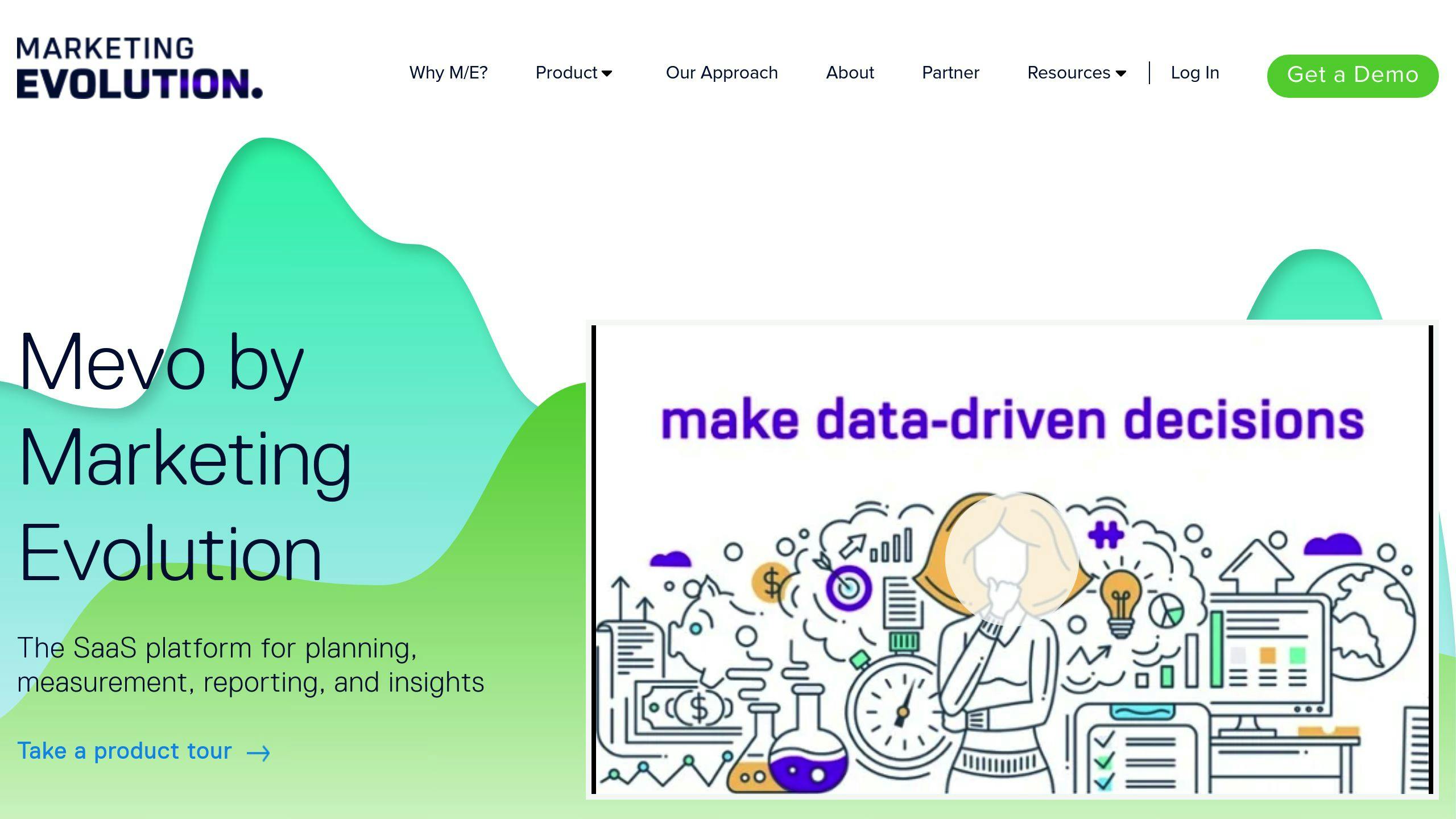
Marketing Evolution (MEVO) brings together data from various marketing channels, allowing marketers to forecast campaigns accurately and make real-time adjustments. Its ability to adapt campaigns on the fly while keeping data secure and compliant makes it a standout tool.
Key Analytics Features
MEVO uses machine learning that improves predictions as fresh data becomes available. With real-time dashboards, marketers can tweak campaigns on the go to boost performance.
| Feature Category | Capabilities |
|---|---|
| Data Integration | Collects data from multiple channels, connects with CRM systems, integrates with social platforms |
| Predictive Modeling | Utilizes machine learning, statistical tools, and customer behavior forecasting |
| Campaign Optimization | Tracks performance in real time, generates automated insights, predicts ROI |
| Security & Compliance | Provides enterprise-level data protection, ensures regulatory compliance, and secure platform integration |
Enterprise Integration
MEVO connects seamlessly with CRMs, email software, and social media platforms, ensuring its predictive models are always working with the most current data. Its advanced machine learning enhances the accuracy of campaign forecasts across all integrated systems.
Scalability and Support
MEVO is designed to grow with businesses, offering deployment options that fit companies of all sizes. It also provides a range of support services, including training sessions, webinars, detailed documentation, and access to experts for complex modeling needs. Pricing is customized, making it a good fit for mid-sized to large enterprises looking for advanced predictive tools.
With its strong focus on security and integration, MEVO is well-suited for businesses with intricate marketing requirements. While it excels in real-time campaign adjustments, platforms like SAP Predictive Analytics may be better for organizations seeking a more structured approach to enterprise-level modeling.
6. SAP Predictive Analytics
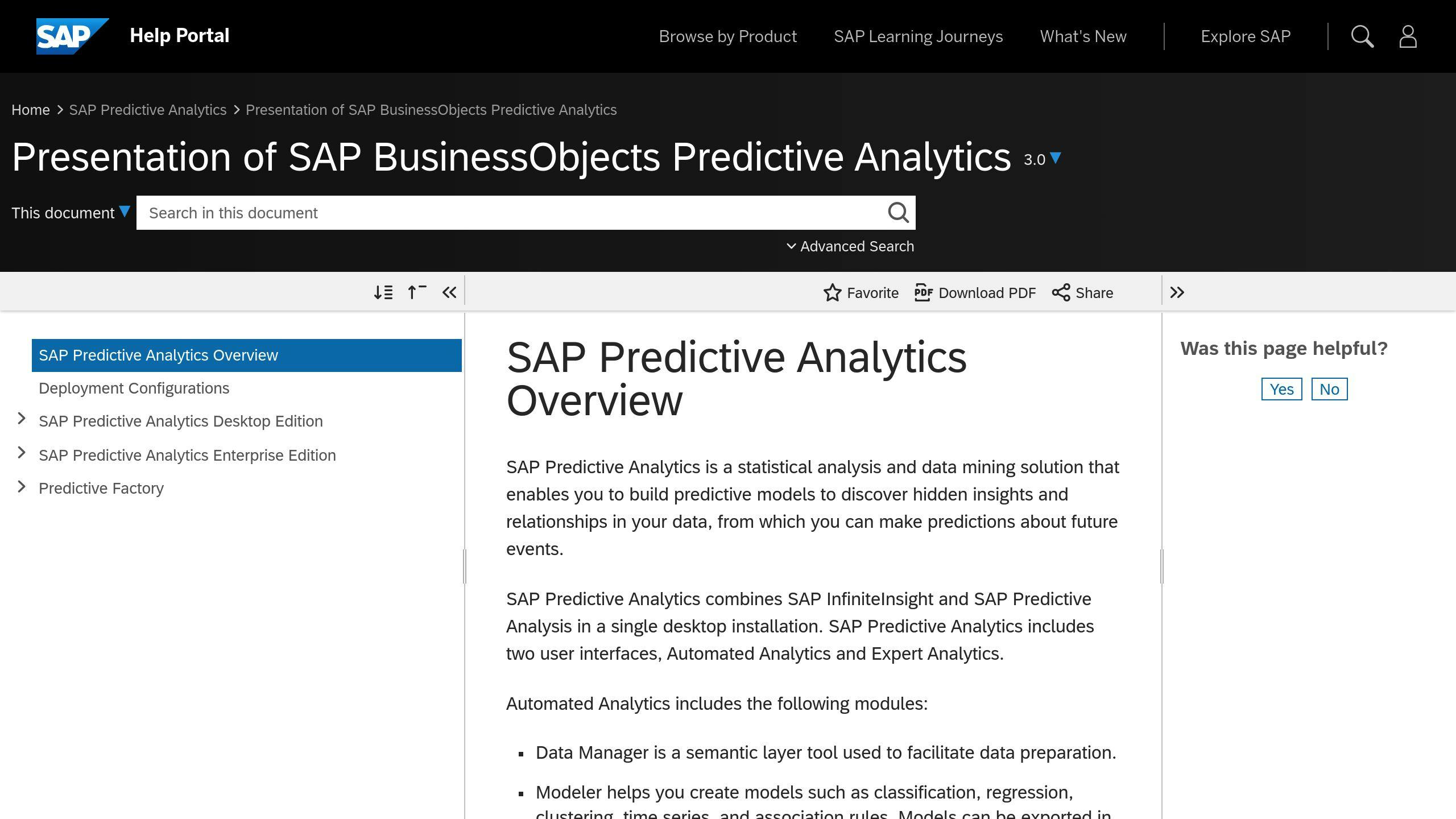
SAP Predictive Analytics is an enterprise-level tool within the SAP Analytics Cloud ecosystem, combining business intelligence, planning, and data science. It offers powerful tools for campaign forecasting, enabling marketers to make accurate, data-driven decisions.
Core Predictive Features
This platform excels in handling complex predictive models while remaining user-friendly. Its self-service tools let marketers create forecasts without needing technical skills.
| Feature Category | Capabilities |
|---|---|
| Predictive Modeling | Uses advanced statistical algorithms, machine learning, and pattern recognition |
| Data Processing | Provides real-time analysis, automated data preparation, and multi-source integration |
| Campaign Tools | Includes scenario simulation, predictive planning, and performance tracking |
| Collaboration | Facilitates cross-department insights and shared forecasting models |
Integration and Scalability
Built on a cloud-based infrastructure, SAP Predictive Analytics integrates seamlessly with other SAP tools and even non-SAP systems, ensuring data consistency. Its cloud setup allows it to grow alongside expanding datasets, making it a reliable choice for businesses with scaling needs.
Scenario Simulation and Planning
One of its standout features is the ability to simulate various campaign scenarios. Marketers can explore different conditions to forecast outcomes and refine their strategies, making their planning more effective.
Implementation and Support
SAP provides extensive training options, including online courses, webinars, and forums, to help users get the most out of the platform. Pricing is tailored to each business, depending on specific needs and deployment options. This makes it especially suitable for medium to large enterprises looking for advanced predictive tools.
SAP Predictive Analytics is ideal for organizations analyzing extensive historical campaign data and requiring seamless integration with existing enterprise systems. While it shines in enterprise-level forecasting, Tableau offers a more visually intuitive approach, making insights easier to grasp for a broader range of users.
7. Tableau

Tableau is a leading platform for data visualization, offering advanced tools for campaign forecasting and performance analysis.
Key Features
Tableau transforms complex data into clear, actionable visuals. It integrates smoothly with marketing platforms, CRM systems, and analytics tools, providing a comprehensive view of campaign performance. Its user-friendly dashboards and cross-platform compatibility help marketers analyze and predict campaign outcomes more effectively than many traditional tools.
| Feature | Description |
|---|---|
| Data Integration | Links with various marketing platforms, CRM systems, and analytics tools |
| Visualization Tools | Offers interactive dashboards and customizable charts for forecasting |
| Predictive Models | Uses machine learning to analyze trends and predict outcomes |
| Real-time Analysis | Processes live data and updates forecasts dynamically |
Enterprise-Level Capabilities
Tableau's pricing structure ranges from $15 to $70 per user per month, tailored to different roles such as data analysts, collaborators, and stakeholders. It prioritizes data security through encryption, access controls, and compliance with key data protection standards. Its scalability ensures reliable performance even for organizations managing extensive datasets, making it suitable for large-scale forecasting.
Support and Accessibility
Tableau provides a range of resources, including training materials, community forums, and dedicated customer support. Its combination of machine learning and customizable dashboards makes predictive insights easy to understand, even for team members without technical expertise. This accessibility makes Tableau a great fit for teams working across different functions to enhance campaign strategies.
Comparison Table
Here’s a breakdown of the leading predictive analytics tools for campaign forecasting:
| Feature/Tool | Pecan AI | Qlik Sense | SAS Advanced Analytics | Alteryx | Marketing Evolution | SAP Predictive | Tableau |
|---|---|---|---|---|---|---|---|
| Core Features | Low-code analytics, Predictive GenAI | Augmented analytics, Code-free UI | Statistical modeling, Simulations | Data mining, Machine learning | Marketing attribution, ROI tools | Statistical modeling, Enterprise-ready | Data visualization, Real-time analysis |
| Target Users | Marketing teams with limited tech skills | Mid-size businesses needing visual tools | Large enterprises with complex data | Data scientists and analysts | Teams focused on ROI | Enterprise-level forecasting | Teams needing visual reports |
| Pricing Model | Custom quotes | Subscription tiers | Custom enterprise pricing | Role-based subscription | Custom pricing | Enterprise quotes | $15-$70 per user/month |
| Marketing Platform Integration | ⭐⭐⭐⭐ | ⭐⭐⭐⭐⭐ | ⭐⭐⭐⭐ | ⭐⭐⭐⭐ | ⭐⭐⭐ | ⭐⭐⭐⭐⭐ | ⭐⭐⭐⭐⭐ |
| Ease of Use | ⭐⭐⭐⭐⭐ | ⭐⭐⭐⭐ | ⭐⭐⭐ | ⭐⭐⭐ | ⭐⭐⭐⭐ | ⭐⭐⭐ | ⭐⭐⭐⭐⭐ |
| Scalability | ⭐⭐⭐⭐ | ⭐⭐⭐⭐ | ⭐⭐⭐⭐⭐ | ⭐⭐⭐⭐ | ⭐⭐⭐ | ⭐⭐⭐⭐⭐ | ⭐⭐⭐⭐ |
Key Differentiators
Each tool serves distinct needs. Pecan AI stands out for its easy-to-use predictive analytics, while SAS Advanced Analytics is built for handling large-scale enterprise data. Qlik Sense focuses on visual insights, making it a top choice for teams prioritizing data visualization.
Pricing Overview
Pricing options range from Tableau’s transparent $15 per user/month plan to custom enterprise pricing models from tools like SAS and SAP. These differences reflect the tools’ features and target users.
Integration and Scalability
SAP Predictive Analytics and Tableau excel in platform connectivity, while Qlik Sense offers robust data integration capabilities. Marketing Evolution is tailored for marketing-specific tech integrations.
For more in-depth comparisons and details, visit the Marketing Analytics Tools Directory (https://topanalyticstools.com).
Choosing the best tool depends on your team's goals, technical skills, and budget.
Conclusion
Picking the right predictive analytics tool can make a big difference in improving marketing performance and ROI. To make the best choice for campaign forecasting, keep these factors in mind:
Integration and Scalability: Look for tools that easily connect with your current marketing setup and can handle future growth. Examples like SAP Predictive Analytics and Tableau are known for their ability to integrate smoothly and scale as your data expands.
Ease of Use: Consider your team's expertise when selecting a tool. For teams without data science skills, platforms like Pecan AI offer user-friendly options. On the other hand, SAS Advanced Analytics provides more advanced features for teams with technical knowledge [1].
If you're just starting out, tools like Pecan AI or Qlik Sense are great entry points. For larger organizations, more comprehensive platforms such as SAS Advanced Analytics or SAP Predictive Analytics might be a better fit due to their advanced analytical capabilities.
To ensure success, start with clean, organized data and regularly compare your forecasts to actual campaign outcomes. For a detailed comparison of predictive analytics tools, check out the Marketing Analytics Tools Directory at https://topanalyticstools.com.


